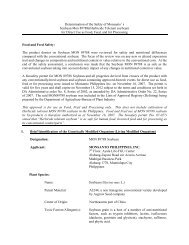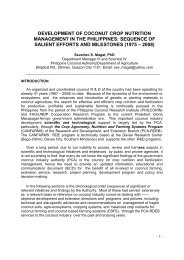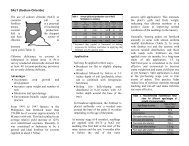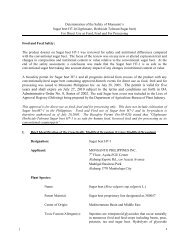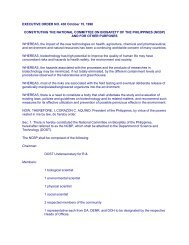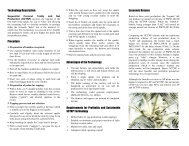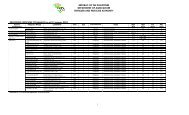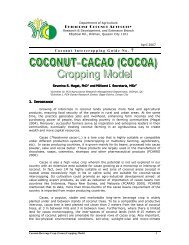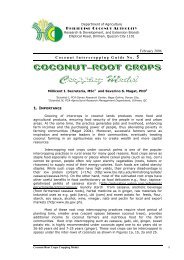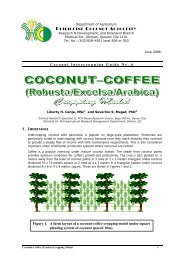2009 Annual Reports - Bureau of Fisheries and Aquatic Resources
2009 Annual Reports - Bureau of Fisheries and Aquatic Resources
2009 Annual Reports - Bureau of Fisheries and Aquatic Resources
You also want an ePaper? Increase the reach of your titles
YUMPU automatically turns print PDFs into web optimized ePapers that Google loves.
BFAR Regional Office 022Nueva Vizcaya 1.3 haBangus 32.25 hectaresCagayan 31.25 haIsabela 1 haSeaweeds 18.64 hectaresCagayan 18.64 haPangasius 11.35 hectaresCagayan 2.15 haIsabela 7.50 haQuirino 0.10 haNueva Vizcaya 1.60 haCBWs / SWIPs 62.02 hectaresCagayan 35 haIsabela 27.02 haAssistance to capture fisheriesFor capture fisheries, the agency hasrendered technical assistance, capability-building<strong>and</strong> livelihood trainings <strong>and</strong> also provided directlivelihood <strong>and</strong> calamity-rehabilitation assistancesuch as fishing gears to coastal fisherfolk. Theprovision <strong>of</strong> fishing gears is subject to requestfrom the recipients themselves. MPA guardians areconsidered as prime beneficiaries. For the year inreview, the bureau was able to provide 36 units(200mx50MDx0.25x7K mon<strong>of</strong>il net/roll) gill nets to:· Claveria(15 units)· Sta. Praxedes (3 units)· Sanchez Mira, Abulug (3 units)· Calayan (3 units)· Claveria (3 units)· Sta Praxedes· Gonzaga(2 units)· Sta. Ana(2 units)· Ballesteros· Sanchez Mira· <strong>and</strong> Pamplona, all in Cagayan provinceThe <strong>of</strong>fice also provided 86 units troll line to theFisherfolk associations <strong>of</strong>:· Abulug (27 units)· Gonzaga (27 units)· Sanchez Mira(27 units)· Claveria (2units)· Pamplona· Sta. Ana <strong>and</strong>· Sta. Praxedes.Trainings conductedparticularly dealt withPayao Design <strong>and</strong>Construction, MPADistribution <strong>of</strong> fishing gear inthe isl<strong>and</strong> town <strong>of</strong> Calayan,Cagayan during the TechnologyCaravan in May.management, Package <strong>of</strong> Technology in <strong>Fisheries</strong>,& Deputy Fish Warden course.Technology demonstration projectsOne <strong>of</strong> the major activities <strong>of</strong> the agencyis the establishment <strong>of</strong> technology demonstrationprojects as means to speed up the dissemination<strong>of</strong> new <strong>and</strong> relevant fishery technologies, mostespecially on aquaculture, at the field level. A lookat the fisheries production <strong>of</strong> region 02 would revealthat the aquaculture sector accounts for 24% <strong>of</strong>the 63,466 MT total fisheries production for <strong>2009</strong>.Although, the total percentage is lower than theaquaculture chunk in the national level, an analysis<strong>of</strong> the trend would reveal an outst<strong>and</strong>ing growthrate <strong>of</strong> 14.8% since 2001. Tilapia, by far, accountsfor the biggest chunk under aquaculture productionwith 74% <strong>and</strong> 26% (from aquaculture <strong>and</strong> municipalinl<strong>and</strong> production) <strong>of</strong> the total fisheries productionin region 02.BFAR RO2 continues to disseminateaquaculture technologies not only to increaseproduction <strong>and</strong> maintain the upward trend, butmore so, to increase fish farmers income, lowertheir production cost in view <strong>of</strong> continued rise inthe price <strong>of</strong> inputs, <strong>and</strong> at the same time safeguardthe environment <strong>and</strong> make aquaculture operationsa sustainable venture.Demo projects are usually established atthe farmers’ level, in order to bring the technologyat the very doorsteps <strong>of</strong> the end users – the farmersthemselves. Farmer cooperators are chosen on thebasis <strong>of</strong> recommendation from the LGUs <strong>and</strong> uponevaluation by the agency. There are generally twotypes <strong>of</strong> demo projects, one is full-support <strong>and</strong>the other is on counterparting scheme. Under fullsupport,the agency provides all the inputs such asfeeds, fingerlings, fertilizer <strong>and</strong> technical assistance.While on counterparting-scheme, the agencyprovides only technical support <strong>and</strong> fingerlings, thesedemos usually are targeted by the LGUs. It can besaid that the full support projects, being dole-out innature, are also means to jumpstart small fish cultureventures in the countryside.For <strong>2009</strong> the agency was able to establishseveral full-support demo projects as follows:Freshwater aquaculture technologies20 sites rice-tilapia cultureCagayan· Alcala (3)



